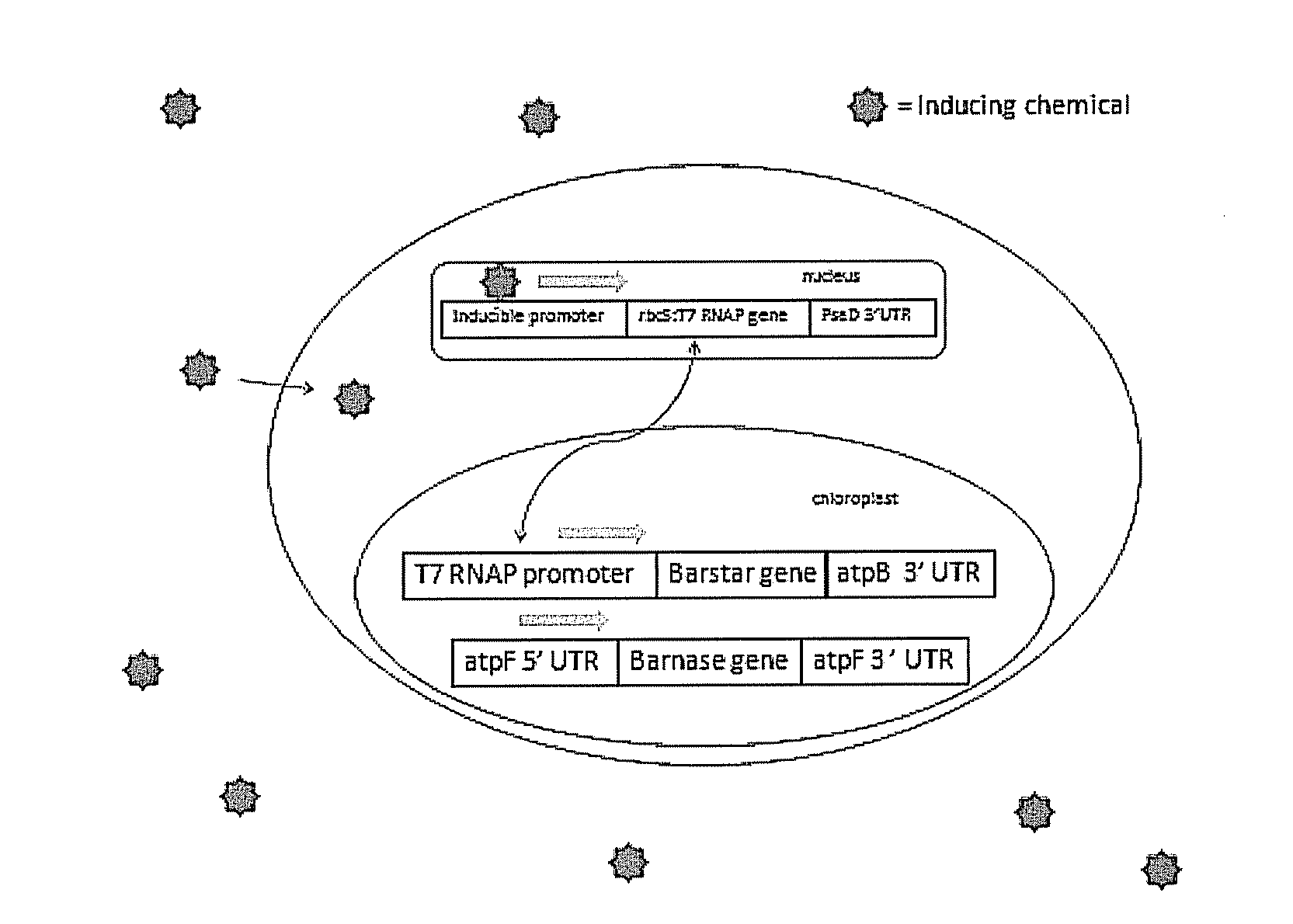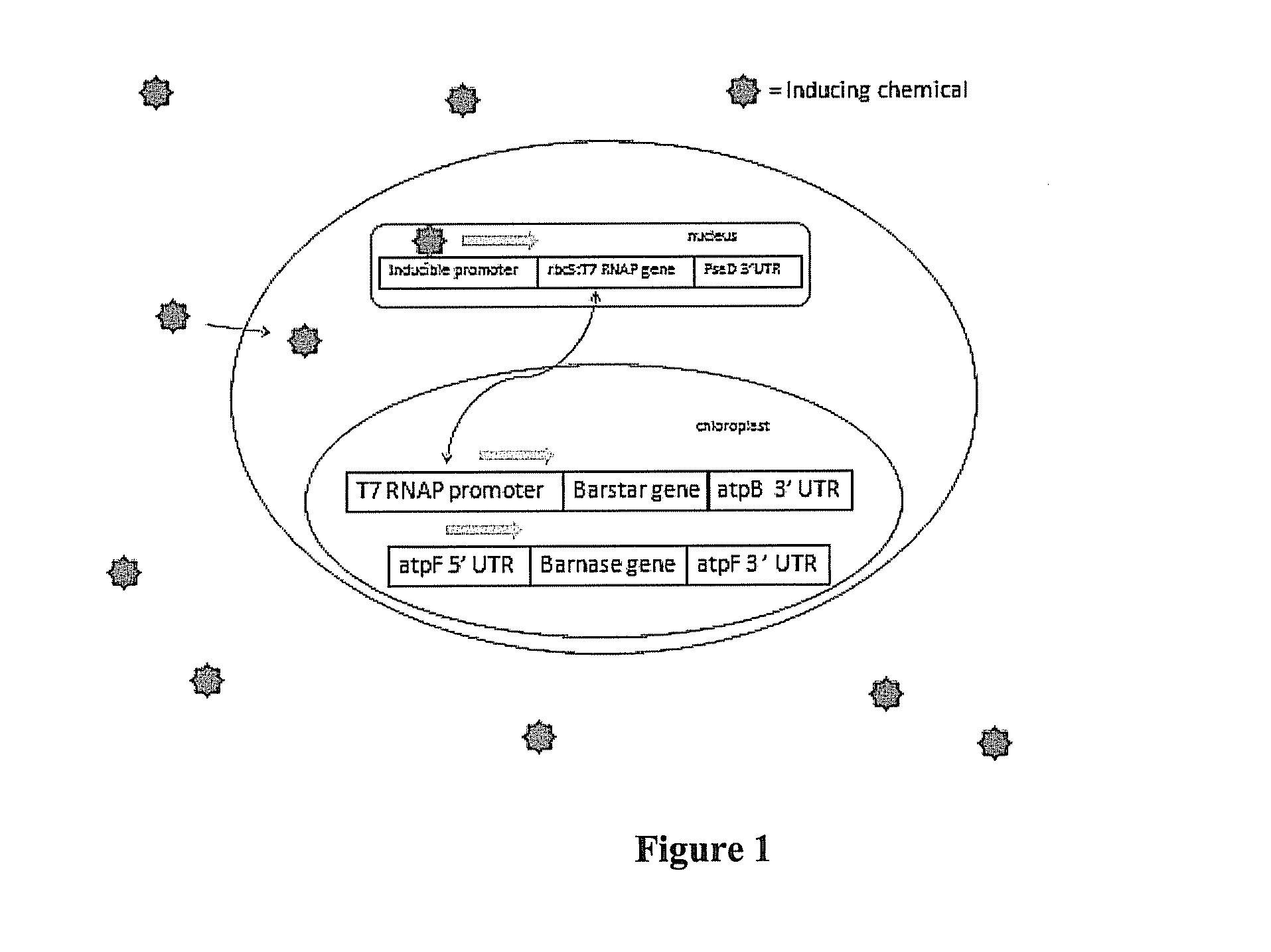Biosecure genetically modified algae
a technology of genetically modified algae and biosecurity, applied in the field of biosecurity genetically modified algae, can solve the problems that the large-scale production of genetically modified organisms (gmo) algae is not done in open pond systems, and achieve the effects of increasing lipid and biomass production
- Summary
- Abstract
- Description
- Claims
- Application Information
AI Technical Summary
Benefits of technology
Problems solved by technology
Method used
Image
Examples
example 1
Regulating Gene Expression in Chloroplasts Using Inducible Promoter
[0069]The chloroplast genome of Chlamydomonas reinhardtii (model system) is transformed by particle bombardment with a plasmid containing an antibiotic (spectinomycin / streptomycin) resistance selectable marker gene (aadA) and an inducible promoter gene. In addition to the aadA and inducible promoter, the transforming plasmid contains an inducer-driven psbA gene, which is required for assembly and function of the Photosystem II complex that drives water oxidation. The plasmid will be integrated by homologous recombination initially into a psbA deletion mutant, which has to be maintained heterotrophically on acetate for growth. At least 600 bp of flanking DNA, located on both sides of the integrating gene constructs (aadA, inducer driven-psbA), will be identical to the target genome to insure efficient recombination. Transgenic strains are identified by spectinomycin resistance and are confirmed for the presence of the...
example 2
Preparation of Flavonoid-Inducible Expression Vectors
[0071]Four plasmid vectors were successfully produced that include the genetic information necessary to control either a gene required for oxygenic photosynthetic activity or the GUS (beta-glucuronidase) reporter gene. The reporter gene has the advantage of being easily detected through standardized biochemical assays. Two constructs contain the full target constructs and two lack the control gene (nodD1) required for inducing the response act as a negative control in physiological tests. The confirmed constructs were then grown in larger volumes for moderate yield plasmid extraction.
[0072]Transformation, selection and screening. The extracted plasmids were then linearized with a restriction enzyme bound to gold beads then transformed into various strains of Chlamydomonas reinhardtii using a microbiolistic approach (i.e., a gene gun). The linearized plasmid vectors contained sequences homologous to the flanking regions around the ...
example 3
Phenotype Characterization Assay to Screen for the Expression of psbA Gene in Transgenic Algae
[0074]A quick assay using natural photosynthetic variable fluorescence to screen for the controlled expression of either psbA or the GUS gene in transgenic algae after induction by various flavonoids has been developed. Natural strains of algae are prone to fluorescent emission of light under conditions of excess illumination. The fluorescence is quenched through biological processes to normal levels in a brief period of time and is thus called “variable fluorescence.” In the absence of psbA, there is no variable fluorescence. Upon induction of psbA gene expression by an inducer molecule (flavonoid or other), the biosecure strain displays photosynthetic activity similar to the wild-type. In the absence of the inducer molecule, the culture will cease producing the psbA protein, lose photosynthetic activity, and switch to a pattern of no variable fluorescence similar to that demonstrated by t...
PUM
| Property | Measurement | Unit |
|---|---|---|
| diameter | aaaaa | aaaaa |
| transparent | aaaaa | aaaaa |
| mechanical | aaaaa | aaaaa |
Abstract
Description
Claims
Application Information
 Login to View More
Login to View More - R&D
- Intellectual Property
- Life Sciences
- Materials
- Tech Scout
- Unparalleled Data Quality
- Higher Quality Content
- 60% Fewer Hallucinations
Browse by: Latest US Patents, China's latest patents, Technical Efficacy Thesaurus, Application Domain, Technology Topic, Popular Technical Reports.
© 2025 PatSnap. All rights reserved.Legal|Privacy policy|Modern Slavery Act Transparency Statement|Sitemap|About US| Contact US: help@patsnap.com


